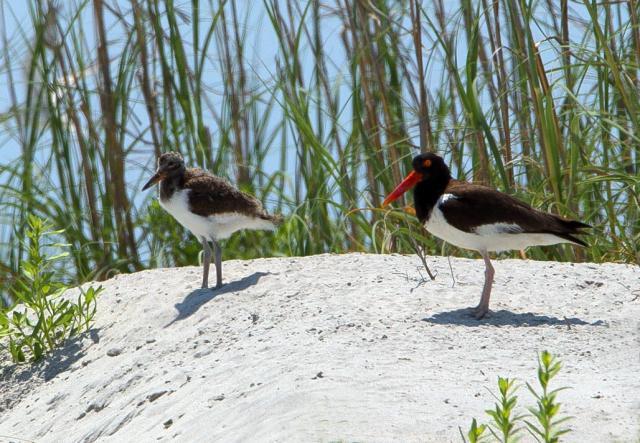For more than 25 years, Audubon North Carolina has managed a network of habitats along North Carolina’s coastal plain offering a haven for birds. With specialized habitats and protection from predators and human disturbance, coastal birds in our state have special places to thrive. Read on to learn more about the Coastal Sanctuary Program and the birds they protect.
With this blog series, we are taking a peak behind the curtain and sharing the secrets of the sanctuaries in North Carolina. Read our first installment of the Cape Fear River sanctuaries here.
Along the Cape Fear River, Audubon North Carolina manages seven coastal sanctuaries that protect essential habitats for waterbirds and shorebirds. With diverse habitats ranging from sand and grass to forest and marsh, this network of islands attracts flocks of waterbirds by the thousands. Species like the White Ibis and Brown Pelican boast thriving populations today because of their breeding success at these sanctuaries.
No Name Island
A natural marsh island along the Cape Fear River surrounded by shallow water, No Name Island has provided a home for nesting American Oystercatchers and Laughing Gulls, and sometimes Brown Pelicans, for many years. Audubon has managed the site since 1990 and works with a number of conservation partners at each sanctuary to protect birds and maintain habitats. Audubon partners with the NC Wildlife Resource Commission at No Name Island.
One of Audubon North Carolina’s 96 Important Bird Areas, North Pelican Island is a manmade sanctuary that provides marsh, shrub thicket and mudflat to nesting birds. Nesting birds found at North Pelican Island over the past 10 years have included:
- Brown Pelican
- Laughing Gull
- American Oystercatcher
- Great Egret
- Snowy Egret
- Cattle Egret
- Tricolored Heron
- Little Blue Heron
- White Ibis
- Glossy Ibis
- Black-crowned Night-Heron
Aside from nesting waterbirds and shorebirds, North Pelican Island has hosted a number of Seaside Sparrow, Least Bittern, Clapper Rail, Marsh Wren, Black Duck, Willet, and other birds.
Since 1990, Audubon has managed North Pelican Island to provide the best possible nesting habitat for birds and has ongoing, long-term monitoring projects, protection from human disturbance, and conducting censuses of nesting birds. Pelican banding and research on pelicans and wading birds has also been conducted at the Sanctuary.
Audubon works with a number of conservation partners at each sanctuary to protect birds and maintain habitats. At North Pelican Island, partners include NC Wildlife Resource Commission, NC State University, along with many researchers.
Shellbed Island
Overseen by Audubon staff, Shellbed Island is a natural island with a shoreline made up of oyster shell “rakes” and marsh habitat. Also identified as an Important Bird Area, the island has been used as a study site for American Oystercatchers where banding, band re-sighting, demographic studies and censuses of oystercatchers have been conducted.
American Oystercatchers and Laughing Gulls nest here, as well as Clapper Rail. Non-nesting species at the island include Saltmarsh and Seaside Sparrow, Northern Harrier, Virginia Rail, many species of waterfowl, shorebirds and wading birds.
Audubon works with a number of conservation partners at each sanctuary to protect birds and maintain habitats. At Shellbed Island, partners include NC Wildlife Resource Commission, NC State University, and NC State Parks.

A manmade island of sand, grass, shrub thicket and marsh habitat, South Pelican Island supports an array of nesting birds including Royal Tern, Sandwich Tern, Brown Pelican, Laughing Gull, American Oystercatcher, Snow Egret, Cattle Egret, Black-crowned Night Heron, and White Ibis. Willets also nest on the island and shorebirds stopover during migration.
As many bird species are attracted to the South Pelican Island, long-term banding studies of American Oystercatchers, Brown Pelicans, Royal Terns, and Sandwich Terns has occurred at the sanctuary. Additional research focused on nesting productivity, demographics, food and foraging, and nesting habitat has also occurred on the sanctuary.
Audubon has managed the sanctuary and Important Bird Area since 1990 by posting, conducting long-term research and monitoring, vegetation management and protecting the birds from human disturbance. Habitat management activities include restoration and enhancement of the island with dredged sand.
Audubon works with a number of conservation partners at each sanctuary to protect birds and maintain habitats. At South Pelican Island, partners include NC Wildlife Resource Commission, NC State University, UNC Wilmington and the US Army Corps of Engineers, along with many other partners. Partnerships with the US Army Corps of Engineers and others encourage the beneficial use of dredged sand to restore and maintain habitat at sites like this one.
Striking Island
Striking Island is a natural island made up of marsh and shell habitats that support nesting American Oystercatchers, Laughing Gulls, Willets, Clapper Rails and occasionally Gull-billed Terns. Saltmarsh and Seaside Sparrows, Clapper Rails, Northern Harriers, shorebirds and wading birds utilize the sanctuary as well.
The sanctuary and Important Bird Area has been managed by Audubon since 1989, but Audubon’s involvement in the management of the sanctuary pre-dates the establishment of our North Carolina Coastal Islands Sanctuary System. Beginning around 1980, Audubon teamed up with the University of North Carolina at Wilmington and Dr. James F. Parnell to protect the island, the island’s birds, and have it serve as a laboratory for scientific research. The island continues to be an important part of the Audubon sanctuary system and continues to serve its original purpose of protecting important habitats for North Carolina waterbirds and shorebirds, as well as advancing our knowledge of coastal birds to further conservation efforts.
Audubon works with a number of conservation partners at each sanctuary to protect birds and maintain habitats. At Striking Island, partners include NC Wildlife Resource Commission, NC State University, and NC State Parks.
Now that you’ve seen the important conservation work happening across our coastal sanctuary system, support the continued protection of our nesting and migrating birds on the coast. Click here to donate to the Coastal Sanctuary Program.



